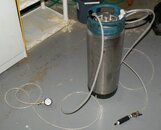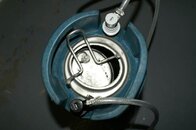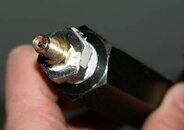First - a disclaimer: If you build this properly it's reasonably dangerous, due to the high pressure that approaches the burst pressure of the keg! This is if it's built properly & operated carefully. Many unforeseen conditions could make this even more dangerous (damage to the keg), so BUILD AT OWN RISK. Only do so if you are COMPLETELY aware of the dangers...
I saw a few threads before about making a test chamber to test your DIY stuff / repairs...
Anyway I made one up, I've attached a few pictures of it.
The main pressure chamber is a used "soda keg". They are often used by people homebrewing beer, so you can find fittings for it at a local beer-making supply store.
The kegs are rated to 150 PSI, have an over-pressure safety valve, an opening that locks so you can't open it pressurized, and two connectors on it.
The "gas in" port on the keg is used to pressurize it. In my case I've got the following in order:
valve to connect to air compressor -> check valve -> in line blow gun -> braided hose goes to keg
The "liquid out" port on the keg is connected to a PSI gauge, which is used to measure the 'depth'.
In operation, the keg is filled to overflowing with water, to avoid having any air pockets in it. Obviously the most dangerous thing to have is a compressible gas in the keg, so it is imperative it is full of water. It takes maybe 15 seconds for a little car-powered air compressor to bring it up to 80 PSI, which would be around 185 feet!
I've tested this with a depth gauge and it seems to work ok! To convert from feet to PSI use Pressure at Water Depth Calculator - but remember you have to subtract 14.7 PSI from all values that calculator gives you. 14.7 PSI being atmospheric pressure, where pressure gauges read 0 PSI.
The hoses are all braided (700 PSI burst), and 10 feet long so I can keep the keg far away from the operator (me!).
The check valve is a hydraulic fluid check valve, but it seems to work. When the compressor is turned off nothing flows back into it... the pressure stays in the system quite well. Pushing the button on the blow gun relieves the pressure without having to approach the keg.
The mating connectors on the keg didn't have a pressure rating I could find, so they may crack and send pieces flying! Keep some sort of guard between you and the connectors, and always have safety glasses on. Also try and secure hoses when possible, just so they don't whip out if the connector slips off..
And when you don't want to use it for scuba testing you could put your homebrew beer in it ;-)
EDIT: If you are in Canada, I got all the parts save the connectors for the keg & keg itself from 'Princess Auto'.
I saw a few threads before about making a test chamber to test your DIY stuff / repairs...
Anyway I made one up, I've attached a few pictures of it.
The main pressure chamber is a used "soda keg". They are often used by people homebrewing beer, so you can find fittings for it at a local beer-making supply store.
The kegs are rated to 150 PSI, have an over-pressure safety valve, an opening that locks so you can't open it pressurized, and two connectors on it.
The "gas in" port on the keg is used to pressurize it. In my case I've got the following in order:
valve to connect to air compressor -> check valve -> in line blow gun -> braided hose goes to keg
The "liquid out" port on the keg is connected to a PSI gauge, which is used to measure the 'depth'.
In operation, the keg is filled to overflowing with water, to avoid having any air pockets in it. Obviously the most dangerous thing to have is a compressible gas in the keg, so it is imperative it is full of water. It takes maybe 15 seconds for a little car-powered air compressor to bring it up to 80 PSI, which would be around 185 feet!
I've tested this with a depth gauge and it seems to work ok! To convert from feet to PSI use Pressure at Water Depth Calculator - but remember you have to subtract 14.7 PSI from all values that calculator gives you. 14.7 PSI being atmospheric pressure, where pressure gauges read 0 PSI.
The hoses are all braided (700 PSI burst), and 10 feet long so I can keep the keg far away from the operator (me!).
The check valve is a hydraulic fluid check valve, but it seems to work. When the compressor is turned off nothing flows back into it... the pressure stays in the system quite well. Pushing the button on the blow gun relieves the pressure without having to approach the keg.
The mating connectors on the keg didn't have a pressure rating I could find, so they may crack and send pieces flying! Keep some sort of guard between you and the connectors, and always have safety glasses on. Also try and secure hoses when possible, just so they don't whip out if the connector slips off..
And when you don't want to use it for scuba testing you could put your homebrew beer in it ;-)
EDIT: If you are in Canada, I got all the parts save the connectors for the keg & keg itself from 'Princess Auto'.








